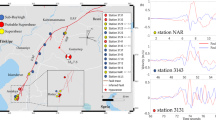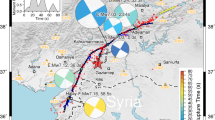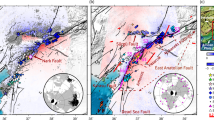Abstract
The Mw 7.8 Kahramanmaraş/Pazarcik earthquake was larger and more destructive than was expected based on historical seismicity in southeastern Turkey in the past few centuries, raising questions about the nature of rupture initiation and propagation. Here we analyse near-field ground velocity records from seismometers to constrain the rupture propagation speed along the Narli splay fault, which hosted the initial rupture that eventually reached the main East Anatolian Fault. The measured particle velocities provide evidence for an early transition of the rupture from sub-Rayleigh to supershear behaviour, whereby the rupture speed exceeds that of the seismic shear waves. The near-in-situ field observational evidence is consistent with mechanistic understanding of supershear rupture. We estimate the instantaneous supershear rupture propagation speed to have been 1.55 times that of the shear wave speed and the sub-Rayleigh-to-supershear transition length to have been around 19.45 km. This work reveals the value of near-field instrumentation in characterizing the initiation of earthquakes along major faults.
This is a preview of subscription content, access via your institution
Access options
Access Nature and 54 other Nature Portfolio journals
Get Nature+, our best-value online-access subscription
$32.99 / 30 days
cancel any time
Subscribe to this journal
Receive 12 print issues and online access
$259.00 per year
only $21.58 per issue
Buy this article
- Purchase on SpringerLink
- Instant access to full article PDF
Prices may be subject to local taxes which are calculated during checkout



Similar content being viewed by others
Data availability
References
M 7.8 - Pazarcik Earthquake, Kahramanmaras Earthquake Sequence (USGS, 2023); https://earthquake.usgs.gov/earthquakes/eventpage/us6000jllz/executive
AFAD. Turkish National Strong Motion Network (Department of Earthquake, Disaster and Emergency Management Authority, 1973); https://doi.org/10.7914/SN/TK
Melgar, D. et al. Sub- and super-shear ruptures during the 2023 Mw 7.8 and Mw 7.6 earthquake doublet in SE Türkiye. Seismica 2, 1–10 (2023).
Barbot, S. et al. Slip distribution of the February 6, 2023 Mw 7.8 and Mw 7.6, Kahramanmaraş, Turkey earthquake sequence in the East Anatolian Fault zone. Seismica 2, 1–17 (2023).
Okuwaki, R., Yagi, Y., Taymaz, T. & Hicks, S. P. Multi-scale rupture growth with alternating directions in a complex fault network during the 2023 south-eastern Turkiye and Syria earthquake doublet. Geophys. Res. Lett. 50, e2023GL103480 (2023).
Zahradnik, J., Turhan, F., Sokos, E. & Gallovifç, F. Asperity-like (segmented) structure of the 6 February 2023 Turkish earthquakes. Preprint at EarthArXiv https://doi.org/10.31223/X5T666 (2023).
Delouis, B., van den Ende, M. & Ampuero, J.-P. Kinematic rupture model of the 6 February 2023 7.8 Türkiye earthquake from a large set of near‐source strong‐motion records combined with GNSS offsets reveals intermittent supershear rupture. Bull. Seismol. Soc. Am. 114, 726–740 (2024).
Kartal, R. F., Kadirioğlu, F. T. & Zünbül, S. Kinematic of East Anatolian Fault and Dead Sea Fault. In Proc. 17th Active Tectonic Research Group Workshop (ATAG 17) (Akdeniz University, 2013); https://www.researchgate.net/publication/271852091
Ambraseys, N. N. Temporary seismic quiescence: SE Turkey. Geophys. J. Int. 96, 311–331 (1989).
Ambraseys, N. N. & Jackson, J. A. Seismicity of the Sea of Marmara (Turkey) since 1500. Geophys. J. Int. 141, F1–F6 (2000).
Emre, O. et al. Active fault database of Turkey. Bull. Earthq. Eng 16, 3229–3275 (2018).
Melgar, D. et al. Rupture kinematics of 2020 January 24 Mw 6.7 Dofüanyol-Sivrice, Turkey earthquake on the East Anatolian Fault Zone imaged by space geodesy. Geophys. J. Int. 223, 862–874 (2020).
Taymaz, T., Eyidogãn, H. & Jackson, J. Source parameters of large earthquakes in the East Anatolian Fault zone (Turkey). Geophys. J. Int. 106, 537–550 (1991).
Taymaz, T. et al. Source mechanism and rupture process of the 24 January 2020 Mw 6.7 Doğanyol-Sivrice earthquake obtained from seismological waveform analysis and space geodetic observations on the East Anatolian Fault zone (Turkey). Tectonophysics 804, 228745 (2021).
Xu, C. et al. Rapid source inversions of the 2023 SE Türkiye earthquakes with teleseismic and strong-motion data. Earthq. Sci. 36, 316–327 (2023).
Wani, F. M., Vemuri, J. & Rajaram, C. Strong ground motion characteristics observed in the February 6, 2023 Mw 7. 7 Türkiye earthquake. Earthq. Sci. 37, 241–262 (2024).
Mai, P. et al. The destructive earthquake doublet of 6 February 2023 in south-central Turkiye and northwestern Syria: initial observations and analyses. Seism. Rec. 3, 105–115 (2023).
Goldberg, D. E. et al. Rapid characterization of the February 2023 Kahramanmaraş, Türkiye, earthquake sequence. Seism. Rec. 3, 156–167 (2023).
Jia, Z. et al. The complex dynamics of the 2023 Kahramanmaraş, Turkey, Mw 7.8–7.7 earthquake doublet. Science 381, 985–990 (2023).
Liu, C. et al. Complex multi-fault rupture and triggering during the 2023 earthquake doublet in southeastern Turkiye. Nat. Commun. 14, 5564 (2023).
Xu, L. et al. The overall-subshear and multi-segment rupture of the 2023 Mw 7.8 Kahramanmaraş, Turkey earthquake in millennia supercycle. Commun. Earth Environ. 4, 379 (2023).
Reitman, N. G. et al. Rapid surface rupture mapping from satellite data: the 2023 Kahramanmaraş, Turkey (Türkiye), earthquake sequence. Seism. Rec. 3, 289–298 (2023).
Kandilli Observatory & Earthquake Research Institute, Boğaziçi University. Kandilli Observatory and Earthquake Research Institute (KOERI) (International Federation of Digital Seismograph Networks, 1971); https://doi.org/10.7914/SN/KO
Rosakis, A. J., Samudrala, O. & Coker, D. Cracks faster than the shear wave speed. Science 284, 1337–1340 (1999).
Bouchon, M. et al. How fast is rupture during an earthquake? New insights from the 1999 Turkey earthquakes. Geophys. Res. Lett. 28, 2723–2726 (2001).
Mello, M., Bhat, H. S. & Rosakis, A. J. Spatiotemporal properties of sub-Rayleigh and supershear rupture velocity fields: theory and experiments. J. Mech. Phys. Solids 93, 153–181 (2016).
Mello, M., Bhat, H. S., Rosakis, A. J. & Kanamori, H. Reproducing the supershear portion of the 2002 Denali earthquake rupture in laboratory. Earth Planet. Sci. Lett. 387, 89–96 (2014).
Lu, X., Rosakis, A. J. & Lapusta, N. Rupture modes in laboratory earthquakes: effect of fault prestress and nucleation conditions. J. Geophys. Res. 115, 1–25 (2010).
Dunham, E. M. & Archuleta, R. J. Evidence for a supershear transient during the 2002 Denali Fault earthquake. Bull. Seismol. Soc. Am. 94, 256–268 (2004).
Zeng, H., Wei, S. & Rosakis, A. A travel-time path calibration strategy for back-projection of large earthquakes and its application and validation through the segmented super-shear rupture imaging of the 2002 Mw 7.9 Denali earthquake. J. Geophys. Res. Solid Earth 127, e2022JB024359 (2022).
Ellsworth, W. et al. Near-field ground motion of the 2002 Denali Fault, Alaska, earthquake recorded at pump station 10. Earthq. Spectra 20, 597–615 (2004).
Mello, M., Bhat, H. S., Rosakis, A. J. & Kanamori, H. Identifying the unique ground motion signatures of supershear earthquakes: theory and experiments. Tectonophysics 493, 297–326 (2010).
Dunham, E. M. & Bhat, H. S. Attenuation of radiated ground motion and stresses from three-dimensional supershear ruptures. J. Geophys. Res. 113, 1–17 (2008).
Hu, F., Oglesby, D. D. & Chen, X. The near-fault ground motion characteristics of sustained and unsustained free surface-induced supershear rupture on strike-slip faults. J. Geophys. Res. Solid Earth 125, e2019JB019039 (2020).
Xu, J., Chen, X., Liu, P. & Zhang, Z. Ground motion signatures of supershear ruptures in the Burridge-Andrews and free-surface-induced mechanisms. Tectonophysics 791, 228570 (2020).
Vyas, J. C., Mai, P. M., Galis, M., Dunham, E. M. & Imperatori, W. Mach wave properties in the presence of source and medium heterogeneity. Geophys. J. Int. 214, 2035–2052 (2018).
Kaneko, Y. & Lapusta, N. Supershear transition due to a free surface in 3-D simulations of spontaneous dynamic rupture on vertical strike-slip faults. Tectonophysics 493, 272–284 (2010).
Somerville, P. G., Smith, N. F., Graves, R. W. & Abrahamson, N. A. Modification of empirical strong ground motion attenuation relations to include the amplitude and duration effects of rupture directivity. Seismol. Res. Lett. 68, 199–222 (1997).
Bray, J. D. & Rodriguez-Marek, A. Characterization of forward-directivity ground motions in the near-fault region. Soil Dyn. Earthq. Eng. 24, 815–828 (2004).
Wang, Y. & Day, S. M. Effects of off-fault inelasticity on near-fault directivity pulses. J. Geophys. Res. Solid Earth 125, 1–29 (2020).
Kearse, J. et al. Strong asymmetry in near-fault ground velocity during an oblique strike-slip earthquake revealed by waveform particle motions and dynamic rupture simulations. Seismica 3, 1–12 (2024).
Abdelmeguid, M., Elbanna, A. & Rosakis, A. Ground motion characteristics of subshear and supershear ruptures in the presence of sediment layers. Geophys. J. Int. 240, 967–987 (2025).
Hu, F., Oglesby, D. D. & Chen, X. The effect of depth-dependent stress in controlling free-surface-induced supershear rupture on strike-slip faults. J. Geophys. Res. Solid Earth 126, e2020JB021459 (2021).
Dunham, E. M. & Archuleta, R. J. Near-source ground motion from steady state dynamic rupture pulses. Geophys. Res. Lett. 32, L03302 (2005).
Ellsworth, W. L. et al. Near-field ground motion of the 2002 Denali Fault, Alaska, earthquake recorded at pump station 10. Earthq. Spectra 20, 597–615 (2004).
Amlani, F. et al. Supershear shock front contribution to the tsunami from the 2018 Mw 7.5 Palu, Indonesia earthquake. Geophys. J. Int. 230, 2089–2097 (2022).
Rubino, V., Rosakis, A. J. & Lapusta, N. Spatiotemporal properties of sub-Rayleigh and supershear ruptures inferred from full-field dynamic imaging of laboratory experiments. J. Geophys. Res. Solid Earth 125, 1–25 (2020).
Aagaard, B. T. & Heaton, T. H. Near-source ground motions from simulations of sustained intersonic and supersonic fault ruptures. Bull. Seismol. Soc. Am. 94, 2064–2078 (2004).
Bernard, P. & Baumont, D. Shear Mach wave characterization for kinematic fault rupture models with constant supershear rupture velocity. Geophys. J. Int. 162, 431–447 (2005).
Güvercin, S. E., Karabulut, H., Konca, A. O., Doßan, U. & Ergintav, S. Active seismotectonics of the East Anatolian Fault. Geophys. J. Int. 230, 50–69 (2022).
Pousse-Beltran, L. et al. The 2020 Mw-6.8 Elazığ (Turkey) earthquake reveals rupture behavior of the East Anatolian Fault. Geophys. Res. Lett. 47, e88136 (2020).
Xia, K., Rosakis, A. J. & Kanamori, H. Laboratory earthquakes: the sub-Rayleigh-to-supershear rupture transition. Science 303, 1859–1861 (2004).
Archuleta, R. J. & Hartzell, S. H. Effects of fault finiteness on near-source ground motion. Bull. Seismol. Soc. Am. 71, 939–957 (1981).
Hall, J. F., Heaton, T. H., Halling, M. W. & Wald, D. J. Near-source ground motion and its effects on flexible buildings. Earthq. Spectra 11, 569–605 (1995).
Freund, L. B. The mechanics of dynamic shear crack propagation. J. Geophys. Res. 84, 2199–2209 (1979).
Abdelmeguid, M. et al. Dynamics of episodic supershear in the 2023 M7.8 Kahramanmaraş/Pazarcik earthquake, revealed by near-field records and computational modeling. Commun. Earth Environ. 4, 456 (2023).
Ben-Zion, Y. A critical data gap in earthquake physics. Seismol. Res. Lett. 90, 1721–1722 (2019).
Das, S. The need to study speed. Science 317, 905–906 (2007).
Harris, R. A. & Day, S. M. Dynamics of fault interaction: parallel strike-slip faults. J. Geophys. Res. 98, 4461–4472 (1993).
Templeton, E. L. et al. Finite element simulations of dynamic shear rupture experiments and dynamic path selection along kinked and branched faults. J. Geophys. Res. 114, B08304 (2009).
Rousseau, C.-E. & Rosakis, A. J. On the influence of fault bends on the growth of sub-Rayleigh and intersonic dynamic shear ruptures. J. Geophys. Res. 108, 2411 (2003).
Rousseau, C. E. & Rosakis, A. J. Dynamic path selection along branched faults: experiments involving sub-Rayleigh and supershear ruptures. J. Geophys. Res. 114, 1–15 (2009).
Bhat, H. S., Dmowska, R., Rice, J. R. & Kame, N. Dynamic slip transfer from the Denali to Totschunda Faults, Alaska: testing theory for fault branching. Bull. Seismol. Soc. Am. 94, S202–S213 (2004).
Ma, X. & Elbanna, A. Dynamic rupture propagation on fault planes with explicit representation of short branches. Earth Planet. Sci. Lett. 523, 115702 (2019).
Yao, S. & Yang, H. Rupture phases reveal geometry-related rupture propagation in a natural earthquake. Sci. Adv. 11, 0154 (2025).
Wang, Z. et al. Dynamic rupture process of the Mw 7.8 Kahramanmaraş earthquake (SE Türkiye): variable rupture speed and implications for seismic hazard. Geophys. Res. Lett. 50, e2023GL104787 (2023).
Gabriel, A.-A., Ulrich, T., Marchandon, M., Biemiller, J. & Rekoske, J. 3D dynamic rupture modeling of the 6 February 2023, Kahramanmaraş, Turkey Mw7.8 and 7.7 earthquake doublet using early observations. Seism. Rec. 3, 342–356 (2023).
Dunham, E. M., Favreau, P. & Carlson, J. M. A supershear transition mechanism for cracks. Science 299, 1557–1559 (2003).
Liu, Y. & Lapusta, N. Transition of mode II cracks from sub-Rayleigh to intersonic speeds in the presence of favorable heterogeneity. J. Mech. Phys. Solids 56, 25–50 (2008).
Huang, Y. & Ampuero, J.-P. Pulse-like ruptures induced by low-velocity fault zones. J. Geophys. Res. 116, 12307 (2011).
Ma, X. & Elbanna, A. E. Effect of off-fault low-velocity elastic inclusions on supershear rupture dynamics. Geophys. J. Int. 203, 664–677 (2015).
Andrews, D. J. Rupture velocity of plane strain shear cracks. J. Geophys. Res. 81, 5679–5687 (1976).
Das, S. & Aki, K. A numerical study of two-dimensional spontaneous rupture propagation. Geophys. J. Int. 50, 643–668 (1977).
Ren, C. et al. Supershear triggering and cascading fault ruptures of the 2023 Kahramanmaraş, Türkiye, earthquake doublet. Science 383, 305–311 (2024).
Liu, C. et al. Complex multi-fault rupture and triggering during the 2023 earthquake doublet in southeastern Türkiye. Nat. Commun. 14, 5564 (2023).
Okuwaki, R., Yagi, Y., Taymaz, T. & Hicks, S. P. Multi-scale rupture growth with alternating directions in a complex fault network during the 2023 south-eastern Türkiye and Syria earthquake doublet. Geophys. Res. Lett. 50, e2023GL103480 (2023).
Bizzarri, A., Dunham, E. M. & Spudich, P. Coherence of Mach fronts during heterogeneous supershear earthquake rupture propagation: simulations and comparison with observations. J. Geophys. Res. 115, B08301 (2010).
Wu, F. et al. Pulse-like ground motion observed during the 6 February 2023 Mw7.8 Pazarcík earthquake (Kahramanmaraş, SE Türkiye). Earthq. Sci. 36, 328–339 (2023).
Beyreuther, M. et al. ObsPy: a Python toolbox for seismology. Seismol. Res. Lett. 81, 530–533 (2010).
Acknowledgements
The ground motion data used in this study can be obtained from AFAD, USGS and the Kandilli Observatory and Earthquake Research Institute. We thank AFAD for setting up dense near-fault observatories and immediately publishing openly accessible data from a huge number of accelerometers during these trying times for Turkey. A.R. acknowledges support from the Caltech/Mechanical and Civil Engineering Big Ideas Fund and Caltech Terrestrial Hazard Observation and Reporting Center. He also acknowledges support from the National Science Foundation (grants EAR-1651235 and EAR-1651235). A.E. acknowledges support from the Southern California Earthquake Center, through a collaborative agreement between the National Science Foundation (grant EAR0529922) and USGS (grant 07HQAG0008), and National Science Foundation CAREER award 1753249 for modelling complex fault zone structures.
Author information
Authors and Affiliations
Contributions
A.R. conceived of and supervised the study. All authors contributed to analysis of the ground motion data, drafted the paper and participated in its revision and finalization.
Corresponding authors
Ethics declarations
Competing interests
The authors declare no competing interests.
Peer review
Peer review information
Nature Geoscience thanks Alice Gabriel and the other, anonymous, reviewer(s) for their contribution to the peer review of this work. Primary Handling Editor: Tamara Goldin, in collaboration with the Nature Geoscience team.
Additional information
Publisher’s note Springer Nature remains neutral with regard to jurisdictional claims in published maps and institutional affiliations.
Extended data
Extended Data Fig. 1 Geometric characteristics of sub-shear and supershear (super-Eshelby) propagation.
(a) Shear wavelets emitted by a shear dislocation form. Superposition of shear wavelets leads to the formation of (b) sub-Rayleigh rupture and (c) shear Mach front of a supershear rupture. Figure reproduced with permission from ref. 32, Elsevier.
Extended Data Fig. 2 The dependency of the ratio of the FP to FN component on the strike angle of the Narli fault.
The ratio of the FP to FN component is greater than 1 at a strike angle of 16∘ and increases further as the angle increases.
Extended Data Fig. 3 The arrival of shock front at TK:4614.
(a) A to-scale schematic of the location of the TK:4614 station relative to station TK:NAR and the epicenter. Green triangles indicate the location of the stations. The epicenter is marked by a yellow star. The red front indicates the shear wave propagation front while the straight black lines represent the shock fronts (Mach lines) associated with supershear speeds. Station TK:4614 is located further away from the Narli fault relative to TK:NAR or TK:4615 rendering theoretical estimates of local rupture speed using ground motion record complex. (b) The strong ground motion at stationS TK:NAR and TK:4614 shows the phase arrival times between the two stations. (c) The strong ground motion (FN and FP) at TK:4614 shows a clear separation between the arrival of the initial peak of the FP and FN components.
Extended Data Fig. 4 Supporting evidence of supershear transition on the Narli fault.
(a) The strong ground motion records showing the E-W component of velocity at both stations TK:NAR (one of the twin stations) and TK:4611. Points A and B highlight the first arrival of shear waves to the respective stations. (b) A map highlighting the location and distance of the two stations with respect to one another. (c) The strong ground motion records showing the FP and FN components of velocity at station TK:4611. Basemap data from OpenStreetMap contributors, 2024.
Rights and permissions
Springer Nature or its licensor (e.g. a society or other partner) holds exclusive rights to this article under a publishing agreement with the author(s) or other rightsholder(s); author self-archiving of the accepted manuscript version of this article is solely governed by the terms of such publishing agreement and applicable law.
About this article
Cite this article
Rosakis, A., Abdelmeguid, M. & Elbanna, A. Near-field evidence for early supershear rupture of the Mw 7.8 Kahramanmaraş earthquake in Turkey. Nat. Geosci. 18, 534–541 (2025). https://doi.org/10.1038/s41561-025-01707-2
Received:
Accepted:
Published:
Issue date:
DOI: https://doi.org/10.1038/s41561-025-01707-2



